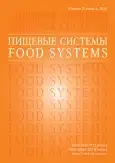Прогнозирование действия энзимов для извлечения веществ с антимикробной направленностью действия из организмов Sus scrofa и Bos taurus
- Авторы: Полищук Е.К.1, Котенкова Е.А.1
-
Учреждения:
- Федеральный научный центр пищевых систем им. В. М. Горбатова
- Выпуск: Том 7, № 1 (2024)
- Страницы: 125-136
- Раздел: Статьи
- URL: https://journal-vniispk.ru/2618-9771/article/view/311344
- DOI: https://doi.org/10.21323/2618-9771-2024-7-1-125-136
- ID: 311344
Цитировать
Полный текст
Аннотация
Ключевые слова
Об авторах
Е. К. Полищук
Федеральный научный центр пищевых систем им. В. М. Горбатова
Email: e.politchuk@fncps.ru
младший научный сотрудник, Экспериментальная клиника-лаборатория биологически активных веществ животного происхождения109316, Москва, ул. Талалихина, 26Teл.: +7–495–676–95–11 (доб.129)
Е. А. Котенкова
Федеральный научный центр пищевых систем им. В. М. Горбатова
Email: e.politchuk@fncps.ru
кандидат технических наук, старший научный сотрудник, Экспериментальная клиника- лаборатория биологически активных веществ животного происхождения109316, Москва, ул. Талалихина, 26Тел.: +7–495–676–92–11 (доб.129)
Список литературы
- Saga, T., Yamaguchi, K. (2009). History of antimicrobial agents and resistant bacteria. Japan Medical Association Journal, 52(2), 103–108.
- Gensini, G. F., Conti, A. A., Lippi, D. (2007). The contributions of Paul Ehrlich to infectious disease. Journal of Infection, 54(3), 221–224. https://doi.org/10.1016/j.jinf.2004.05.022
- Wang, J., Dou, X., Song, J., Lyu, Y., Zhu, X., Xu, L. et al. (2019). Antimicrobial peptides: Promising alternatives in the post feeding antibiotic era. Medicinal Research Reviews, 39(3), 831–859. https://doi.org/10.1002/med.21542
- Magana, M., Pushpanathan, M., Santos, A. L., Leanse, L., Fernandez, M., Ioannidis, A. et al. (2020). The value of antimicrobial peptides in the age of resistance. The Lancet Infectious Diseases, 20(9), e216–e230. https://doi.org/10.1016/S14733099(20)30327-3
- Bechinger, B., Gorr, S.-U. (2017). Antimicrobial peptides: Mechanisms of action and resistance. Journal of Dental Research, 96(3), 254–260. https://doi.org/10.1177/0022034516679973
- APD3: Antimicrobial Peptide Database. Retrieved from https://aps.unmc.edu/. Accessed January 24, 2024.
- Katedra Biochemii Żywności. Bioactive peptide databases. Retrieved from https://biochemia.uwm.edu.pl/bioactive-peptide-databases/. Accessed January 24, 2024.
- Huan, Y., Kong, Q., Mou, H., Yi, H. (2020). Antimicrobial peptides: Classification, design, application and research progress in multiple fields. Frontiers in Microbiology, 11, Article 582779. https://doi.org/10.3389/fmicb.2020.582779
- Bhattacharjya, S., Mohid, S. A., Bhunia, A. (2022). Atomic-resolution structures and mode of action of clinically relevant antimicrobial peptides. International Journal of Molecular Sciences, 23(9), Article 4558. https://doi.org/10.3390/ijms23094558
- Reddy, K. V. R., Yedery, R. D., Aranha, C. (2004). Antimicrobial peptides: Premises and promises. International Journal of Antimicrobial Agents, 24(6), 536–547. https://doi.org/10.1016/j.ijantimicag.2004.09.005
- Hanson, M. A., Lemaitre, B., Unckless, R. L. (2019). Dynamic evolution of antimicrobial peptides underscores trade-offs between immunity and ecological fitness. Frontiers in Immunology, 10, Article 2620. https://doi.org/10.3389/fimmu.2019.02620
- Zhang, L.-J., Gallo, R. L. (2016). Antimicrobial peptides. Current Biology, 26(1), R14–R19. https://doi.org/10.1016/j.cub.2015.11.017
- Keymanesh, K., Soltani, S., Sardari, S. (2009). Application of antimicrobial peptides in agriculture and food industry. World Journal of Microbiology and Biotechnology, 25(6), 933–944. https://doi.org/10.1007/s11274-009-9984-7
- Barashkova, A. S., Rogozhin, E. A. (2020). Isolation of antimicrobial peptides from different plant sources: Does a general extraction method exist? Plant Methods, 16(1), Article 143. https://doi.org/10.1186/s13007-020-00687-1
- Sultana, A., Luo, H., Ramakrishna, S. (2021). Harvesting of antimicrobial peptides from insect (Hermetia illucens) and its applications in the food packaging. Applied Sciences, 11(15), Article 6991. https://doi.org/10.3390/app1115699
- Vizioli, J., Salzet, M. (2002). Antimicrobial peptides from animals: Focus on invertebrates. Trends in Pharmacological Sciences, 23(11), 494–496. https://doi.org/10.1016/S0165-6147(02)02105-3
- UniProt Protein Database. Retrieved from http://www.uniprot.org/. Accessed January 24, 2024.
- Dau, T., Bartolomucci, G., Rappsilber, J. (2020). Proteomics using protease alternatives to trypsin benefits from sequential digestion with trypsin. Analytical Chemistry, 92(14), 9523–9527. https://doi.org/10.1021/acs.analchem.0c00478
- Trypsin-1. Retrieved from https://www.uniprot.org/uniprot/P07477. Accessed January 25, 2024.
- Bioinformatics explained: Proteolytic cleavage. QIAGEN Digital Insights. Retrieved from https://resources.qiagenbioinformatics.com/manuals/clcgenomicsworkbench/650/BE_Proteolytic_cleavage.html. Accessed February 6, 2024.
- Ebbensgaard, A., Mordhorst, H., Overgaard, M. T., Nielsen, C. G., Aarestrup, F. M., Hansen, E. B. (2015). Comparative evaluation of the antimicrobial activity of different antimicrobial peptides against a range of pathogenic bacteria. PLoS ONE, 10(12), Article e0144611. https://doi.org/10.1371/journal.pone.0144611
- Daneshi, M., Caton, J. S., Caixeta, L. S., Eftekhari, Z., Ward, A. K. (2023). Expression, regulation, and function of β-defensins in the bovine mammary glands: Current knowledge and future perspectives. Animals, 13(21), Article 3372. https://doi.org/10.3390/ani13213372
- Elastase, neutrophil expressed. Retrieved from https://www.uniprot.org/uniprot/A0A286ZN14. Accessed January 24, 2024.
- Vizovišek, M., Vidmar, R., Fonović, M., Turk, B. (2016). Current trends and challenges in proteomic identification of protease substrates. Biochimie, 122, 77–87. https://doi.org/10.1016/j.biochi.2015.10.017
- Degasperi, M., Sgarra, R., Mardirossian, M., Pacor, S., Maschio, M., Scocchi, M. (2022). Elastase-activated antimicrobial peptide for a safer pulmonary treatment of cystic fibrosis infections. Antibiotics, 11(3), Article 319. https://doi.org/10.3390/antibiotics11030319
- Collagenase ColG. Retrieved from https://www.uniprot.org/uniprotkb/Q9X721/entry. Accessed February 6, 2024.
- Eckhard, U., Huesgen, P. F., Brandstetter, H., Overall, C. M. (2014). Proteomic protease specificity profiling of clostridial collagenases reveals their intrinsic nature as dedicated degraders of collagen. Journal of Proteomics, 100, 102–114. https://doi.org/10.1016/j.jprot.2013.10.004
- Cantisani, M., Finamore, E., Mignogna, E., Falanga, A., Nicoletti, G. F., Pedone, C. et al. (2014). Structural insights into and activity analysis of the antimicrobial peptide myxinidin. Antimicrobial Agents and Chemotherapy, 58(9), 5280–5290. https://doi.org/10.1128/AAC.02395-14
- Лукинова, E. A., Котенкова, E. A., Полищук, E. K. (2018). Изучение антимикробных свойств биологически активных веществ животного происхождения в зависимости от методологии их выделения. Теория и практика переработки мяса, 3(3), 27–35. https://doi.org/10.21323/2414-438X-2018-3-3-27-35
- Кораблева, Е. С., Берлов, У., Андреева, Ю. В., Кокряков, В. Н. (2007). Антимикробный пептид из лейкоцитов собаки: структурно-функциональные свойства. Вестник Санкт-Петербургского университета. Серия 3. Биология, 3, 80–88.
- Юхнев, В. А., Шартукова, М. А., Луговкина, Н. В., Кокряков, В. Н., Шамова, О. В. (2014). Поиск новых антимикробных пептидов из семейства кателицидинов и дефенсинов в лейкоцитах лося (Alces alces). Вестник СПбГУ. Серия 3. Биология, 1, 115–131.
- Wirnt, R. (1965). Trypsin. Chapter in a book: Methods of Enzymatic Analysis. Academic Press, 1965. https://doi.org/10.1016/B978-0-12-395630-9.50146-8
- Creative Enzymes. Collagenase. Retrieved from https://www.creative-enzymes.com/similar/collagenase_148.html. Accessed February 5, 2024.
- Korkmaz, B., Gauthier, F. (2013). Elastase-2/Leukocyte Elastase. Chapter in a book: Handbook of Proteolytic Enzymes. Academic Press, 2013. https://doi.org/10.1016/B978-0-12-382219-2.00587-1
- Expasy. PeptideCutter. Retrieved from https://web.expasy.org/peptide_cutter/. Accessed February 5, 2024.
Дополнительные файлы








